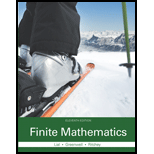
Manufacturing (Note: Exercises #x2013;20 are from qualification examinations For Certified Public Accountants.) The Random Company manufactures two products, Zeta and Beta. Each product must pass through two processing operations. All materials are introduced at the start of Process No. 1. There are no work-in-process inventories. Random may produce either one product exclusively or various combinations of both products subject to the following constraints:
| Process No.1 | Process No. 2 | Contribution Margin (per unit) | |
| Hours Required to Produce One Unit: | |||
| Zeta | 1 hr | 1 hr | $4.00 |
| Beta | 2 hr | 3 hr | $5.25 |
| Total Capacity (in hours per day) | 1000 hr | 1275 hr |
A shortage of technical labor has limited Beta production to 400 units per day. There are no constraints on the production of Zeta other than the hour constraints in the above schedule. Assume that all relationships between capacity and production are linear. Source: American Institute of Certified Public Accountants.
Given the objective to maximize total contribution margin, what is the production constraint for Process No. 1? (Choose one of the following.)
(a) Zeta + Beta ≤ 1000 (b) Zeta + 2 Beta ≤ 1000
(c) Zeta + Beta ≥ 1000 (d) Zeta + 2 Beta ≥ 1000
Want to see the full answer?
Check out a sample textbook solution
Chapter 3 Solutions
Finite Mathematics (11th Edition)
- No chatgpt pls will upvotearrow_forwardFind all solutions of the polynomial congruence x²+4x+1 = 0 (mod 143). (The solutions of the congruence x² + 4x+1=0 (mod 11) are x = 3,4 (mod 11) and the solutions of the congruence x² +4x+1 = 0 (mod 13) are x = 2,7 (mod 13).)arrow_forwardhttps://www.hawkeslearning.com/Statistics/dbs2/datasets.htmlarrow_forward
- Determine whether each function is an injection and determine whether each is a surjection.The notation Z_(n) refers to the set {0,1,2,...,n-1}. For example, Z_(4)={0,1,2,3}. f: Z_(6) -> Z_(6) defined by f(x)=x^(2)+4(mod6). g: Z_(5) -> Z_(5) defined by g(x)=x^(2)-11(mod5). h: Z*Z -> Z defined by h(x,y)=x+2y. j: R-{3} -> R defined by j(x)=(4x)/(x-3).arrow_forwardDetermine whether each function is an injection and determine whether each is a surjection.arrow_forwardLet A = {a, b, c, d}, B = {a,b,c}, and C = {s, t, u,v}. Draw an arrow diagram of a function for each of the following descriptions. If no such function exists, briefly explain why. (a) A function f : AC whose range is the set C. (b) A function g: BC whose range is the set C. (c) A function g: BC that is injective. (d) A function j : A → C that is not bijective.arrow_forward
- Let f:R->R be defined by f(x)=x^(3)+5.(a) Determine if f is injective. why?(b) Determine if f is surjective. why?(c) Based upon (a) and (b), is f bijective? why?arrow_forwardLet f:R->R be defined by f(x)=x^(3)+5.(a) Determine if f is injective.(b) Determine if f is surjective. (c) Based upon (a) and (b), is f bijective?arrow_forwardPlease as many detarrow_forward

 Algebra for College StudentsAlgebraISBN:9781285195780Author:Jerome E. Kaufmann, Karen L. SchwittersPublisher:Cengage Learning
Algebra for College StudentsAlgebraISBN:9781285195780Author:Jerome E. Kaufmann, Karen L. SchwittersPublisher:Cengage Learning Big Ideas Math A Bridge To Success Algebra 1: Stu...AlgebraISBN:9781680331141Author:HOUGHTON MIFFLIN HARCOURTPublisher:Houghton Mifflin Harcourt
Big Ideas Math A Bridge To Success Algebra 1: Stu...AlgebraISBN:9781680331141Author:HOUGHTON MIFFLIN HARCOURTPublisher:Houghton Mifflin Harcourt Linear Algebra: A Modern IntroductionAlgebraISBN:9781285463247Author:David PoolePublisher:Cengage Learning
Linear Algebra: A Modern IntroductionAlgebraISBN:9781285463247Author:David PoolePublisher:Cengage Learning



